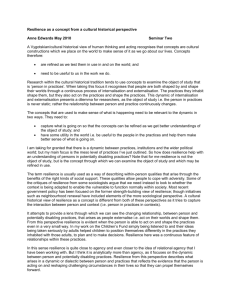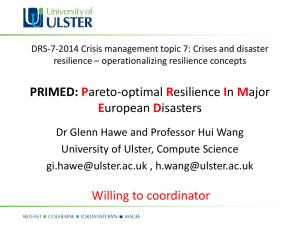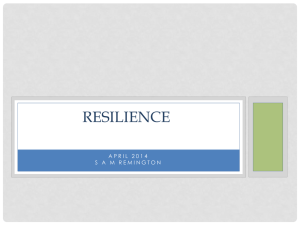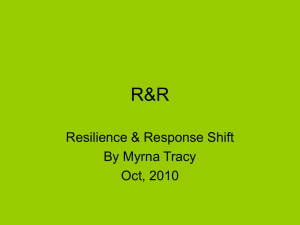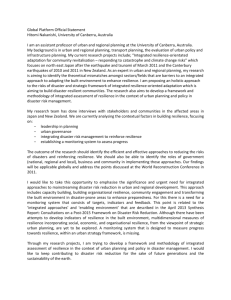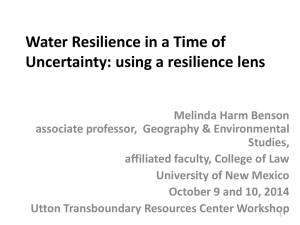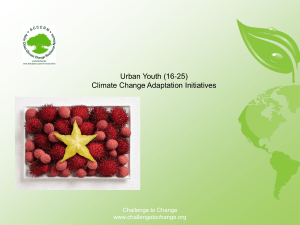Resiliency in School Settings
advertisement
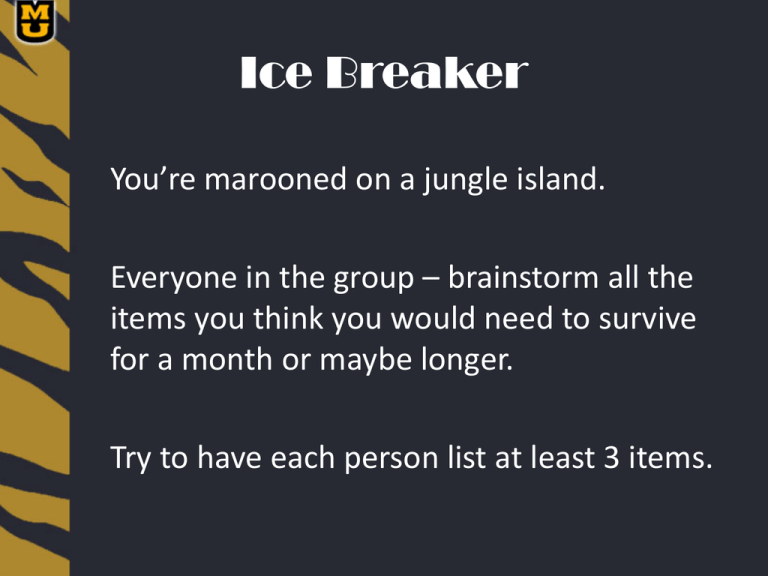
Ice Breaker You’re marooned on a jungle island. Everyone in the group – brainstorm all the items you think you would need to survive for a month or maybe longer. Try to have each person list at least 3 items. Ice Breaker Okay, so now you can only take 3 items from your total list. Discuss what those three items should be and why. Then we’ll share your 3 items with the larger group. Resiliency in School Settings Sandy Sites, Ed.S Ed Morris, Ph.D Jim Koller, Ph.D APA Resilience Definition The process of adapting well in the face of adversity, trauma, tragedy, threats, or even significant sources of stress – such as family and relationship problems, serious health problems, or work place and financial stressors. It means “bouncing back” from difficult experiences. Defining Resilience for Yourself It’s not a set program It is a dynamic process, a journey – not an event Our idea, our attitude, of it determines how we work with it It is individual and environmental At risk / deficits bias At promise / strengths bias Resilience It resides in the individual person and in the environment What Common Characteristics Emerge from the Literature that Are Found in Resilient Youth? Social Competence Good-natured, friendly Accepting Sense of Control Proactive/Problem Solving Self-management Promote these internal characteristics Henderson & Milstein’s Six Strategies for Promoting Resilience 1) Opportunities for meaningful participation. 2) Setting/communicating high expectations. 3) Caring and supportive relationships. 4) Promoting prosocial bonding. 5) Setting clear/consistent boundaries. 6) Teaching “life skills.” Tips for Building Resilience Make connections Help others; encourage involvement Emphasize “good” over “mistakes” Set reasonable, realistic goals Move toward goals – take baby steps Maintain a sense of humor Tips for Building Resilience Be hopeful, have faith and be positive Keep things in perspective Maintain a routine with breaks Eat well and exercise regularly Accept that change is a part of life Resources • Brown, J.H., D’Emidio-Caston, M., & Benard, B. (2001). Resilience Education. Corwin Press, Inc. • Davis, N.J. (1999). Resilience: Status of the Research and Research-Based Programs (working paper – 5/28/99). Substance Abuse & Mental Health Services Administration. • Henderson, N. & Milstein, M. (1996). Resilience in Schools: Making It Happen for Students and Educators. Corwin Press, Inc. • Johnson & Johnson (1996). Teaching students to be peacemakers. Research/Practice, 4(3), 10-19. • Miller, J.B. & Stiver, I.P. (1997). The Healing Connection: How Women Form Relationships in Therapy and in Life. Beacon Press. This presentation acknowledges the Substance Abuse and Mental Health Services Administration’s Center for Mental Health Services and Angela M. Oddone (MSW) Mental Wellness Program Coordinator © NEA Health Information Network 2002 and Illustrations © Mary Garner Mitchell 2002. Activity • • • • Ground Rules Safe & confidential environment No mention of specific names Be respectful, listen, allow everyone the opportunity to speak Identify a spokesperson Activity Discuss 3 stressors in your life: work, home, personal. How do you deal with it? Activity What do you think are 3 stressors your students face? How do they deal with it? Activity What overlap to you see between your students and you? Stressors Solutions





